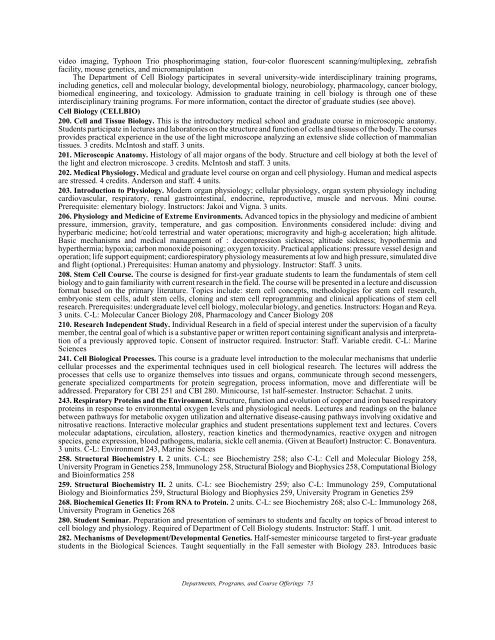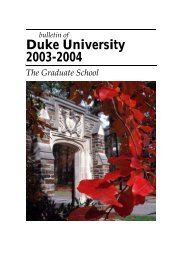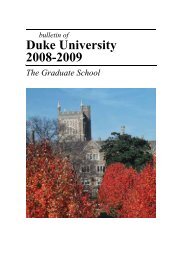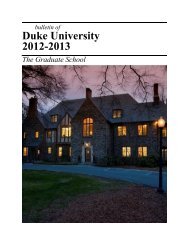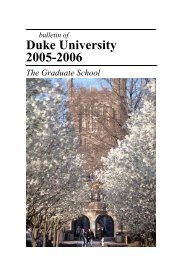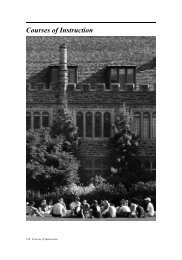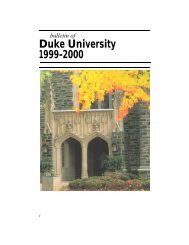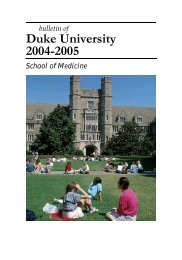Duke University 2009-2010 - Office of the Registrar - Duke University
Duke University 2009-2010 - Office of the Registrar - Duke University
Duke University 2009-2010 - Office of the Registrar - Duke University
You also want an ePaper? Increase the reach of your titles
YUMPU automatically turns print PDFs into web optimized ePapers that Google loves.
video imaging, Typhoon Trio phosphorimaging station, four-color fluorescent scanning/multiplexing, zebrafish<br />
facility, mouse genetics, and micromanipulation<br />
The Department <strong>of</strong> Cell Biology participates in several university-wide interdisciplinary training programs,<br />
including genetics, cell and molecular biology, developmental biology, neurobiology, pharmacology, cancer biology,<br />
biomedical engineering, and toxicology. Admission to graduate training in cell biology is through one <strong>of</strong> <strong>the</strong>se<br />
interdisciplinary training programs. For more information, contact <strong>the</strong> director <strong>of</strong> graduate studies (see above).<br />
Cell Biology (CELLBIO)<br />
200. Cell and Tissue Biology. This is <strong>the</strong> introductory medical school and graduate course in microscopic anatomy.<br />
Students participate in lectures and laboratories on <strong>the</strong> structure and function <strong>of</strong> cells and tissues <strong>of</strong> <strong>the</strong> body. The courses<br />
provides practical experience in <strong>the</strong> use <strong>of</strong> <strong>the</strong> light microscope analyzing an extensive slide collection <strong>of</strong> mammalian<br />
tissues. 3 credits. McIntosh and staff. 3 units.<br />
201. Microscopic Anatomy. Histology <strong>of</strong> all major organs <strong>of</strong> <strong>the</strong> body. Structure and cell biology at both <strong>the</strong> level <strong>of</strong><br />
<strong>the</strong> light and electron microscope. 3 credits. McIntosh and staff. 3 units.<br />
202. Medical Physiology. Medical and graduate level course on organ and cell physiology. Human and medical aspects<br />
are stressed. 4 credits. Anderson and staff. 4 units.<br />
203. Introduction to Physiology. Modern organ physiology; cellular physiology, organ system physiology including<br />
cardiovascular, respiratory, renal gastrointestinal, endocrine, reproductive, muscle and nervous. Mini course.<br />
Prerequisite: elementary biology. Instructors: Jakoi and Vigna. 3 units.<br />
206. Physiology and Medicine <strong>of</strong> Extreme Environments. Advanced topics in <strong>the</strong> physiology and medicine <strong>of</strong> ambient<br />
pressure, immersion, gravity, temperature, and gas composition. Environments considered include: diving and<br />
hyperbaric medicine; hot/cold terrestrial and water operations; microgravity and high-g acceleration; high altitude.<br />
Basic mechanisms and medical management <strong>of</strong> : decompression sickness; altitude sickness; hypo<strong>the</strong>rmia and<br />
hyper<strong>the</strong>rmia; hypoxia; carbon monoxide poisoning; oxygen toxicity. Practical applications: pressure vessel design and<br />
operation; life support equipment; cardiorespiratory physiology measurements at low and high pressure, simulated dive<br />
and flight (optional.) Prerequisites: Human anatomy and physiology. Instructor: Staff. 3 units.<br />
208. Stem Cell Course. The course is designed for first-year graduate students to learn <strong>the</strong> fundamentals <strong>of</strong> stem cell<br />
biology and to gain familiarity with current research in <strong>the</strong> field. The course will be presented in a lecture and discussion<br />
format based on <strong>the</strong> primary literature. Topics include: stem cell concepts, methodologies for stem cell research,<br />
embryonic stem cells, adult stem cells, cloning and stem cell reprogramming and clinical applications <strong>of</strong> stem cell<br />
research. Prerequisites: undergraduate level cell biology, molecular biology, and genetics. Instructors: Hogan and Reya.<br />
3 units. C-L: Molecular Cancer Biology 208, Pharmacology and Cancer Biology 208<br />
210. Research Independent Study. Individual Research in a field <strong>of</strong> special interest under <strong>the</strong> supervision <strong>of</strong> a faculty<br />
member, <strong>the</strong> central goal <strong>of</strong> which is a substantive paper or written report containing significant analysis and interpretation<br />
<strong>of</strong> a previously approved topic. Consent <strong>of</strong> instructor required. Instructor: Staff. Variable credit. C-L: Marine<br />
Sciences<br />
241. Cell Biological Processes. This course is a graduate level introduction to <strong>the</strong> molecular mechanisms that underlie<br />
cellular processes and <strong>the</strong> experimental techniques used in cell biological research. The lectures will address <strong>the</strong><br />
processes that cells use to organize <strong>the</strong>mselves into tissues and organs, communicate through second messengers,<br />
generate specialized compartments for protein segregation, process information, move and differentiate will be<br />
addressed. Preparatory for CBI 251 and CBI 280. Minicourse, 1st half-semester. Instructor: Schachat. 2 units.<br />
243. Respiratory Proteins and <strong>the</strong> Environment. Structure, function and evolution <strong>of</strong> copper and iron based respiratory<br />
proteins in response to environmental oxygen levels and physiological needs. Lectures and readings on <strong>the</strong> balance<br />
between pathways for metabolic oxygen utilization and alternative disease-causing pathways involving oxidative and<br />
nitrosative reactions. Interactive molecular graphics and student presentations supplement text and lectures. Covers<br />
molecular adaptations, circulation, allostery, reaction kinetics and <strong>the</strong>rmodynamics, reactive oxygen and nitrogen<br />
species, gene expression, blood pathogens, malaria, sickle cell anemia. (Given at Beaufort) Instructor: C. Bonaventura.<br />
3 units. C-L: Environment 243, Marine Sciences<br />
258. Structural Biochemistry I. 2 units. C-L: see Biochemistry 258; also C-L: Cell and Molecular Biology 258,<br />
<strong>University</strong> Program in Genetics 258, Immunology 258, Structural Biology and Biophysics 258, Computational Biology<br />
and Bioinformatics 258<br />
259. Structural Biochemistry II. 2 units. C-L: see Biochemistry 259; also C-L: Immunology 259, Computational<br />
Biology and Bioinformatics 259, Structural Biology and Biophysics 259, <strong>University</strong> Program in Genetics 259<br />
268. Biochemical Genetics II: From RNA to Protein. 2 units. C-L: see Biochemistry 268; also C-L: Immunology 268,<br />
<strong>University</strong> Program in Genetics 268<br />
280. Student Seminar. Preparation and presentation <strong>of</strong> seminars to students and faculty on topics <strong>of</strong> broad interest to<br />
cell biology and physiology. Required <strong>of</strong> Department <strong>of</strong> Cell Biology students. Instructor: Staff. 1 unit.<br />
282. Mechanisms <strong>of</strong> Development/Developmental Genetics. Half-semester minicourse targeted to first-year graduate<br />
students in <strong>the</strong> Biological Sciences. Taught sequentially in <strong>the</strong> Fall semester with Biology 283. Introduces basic<br />
Departments, Programs, and Course Offerings 73


